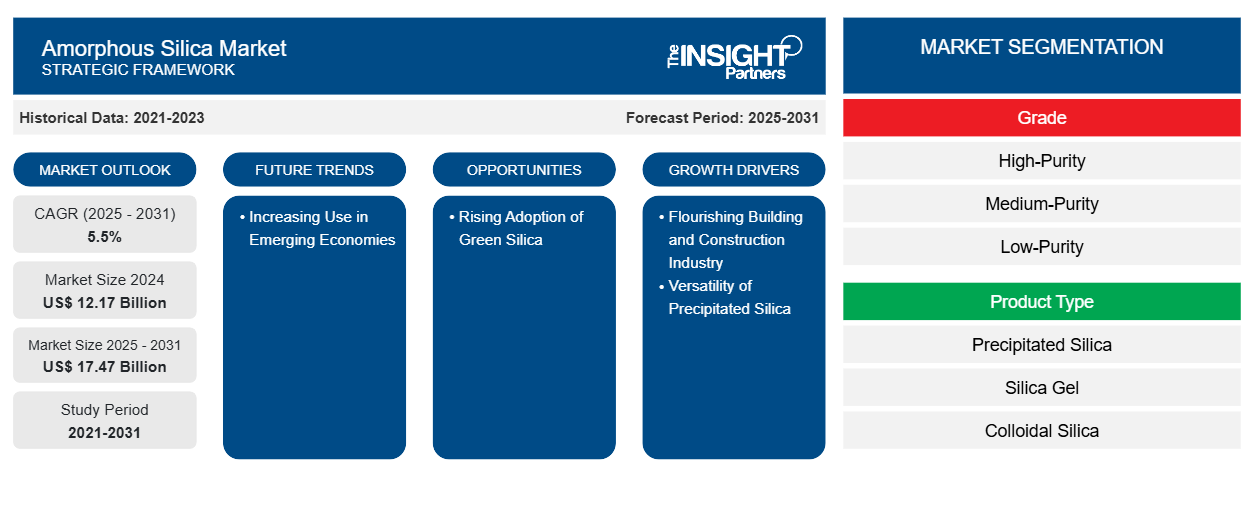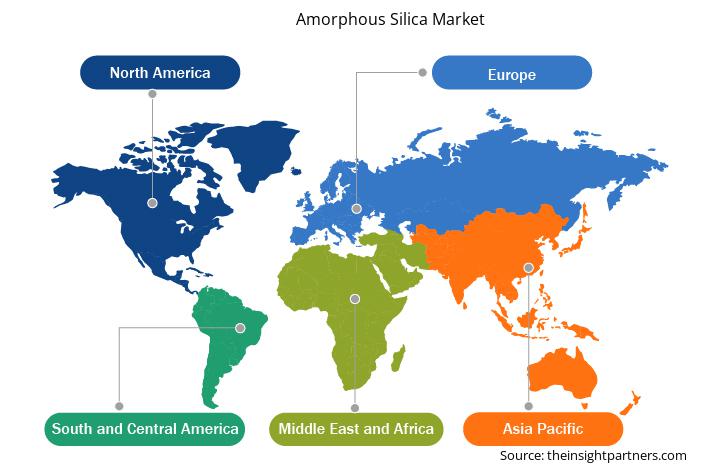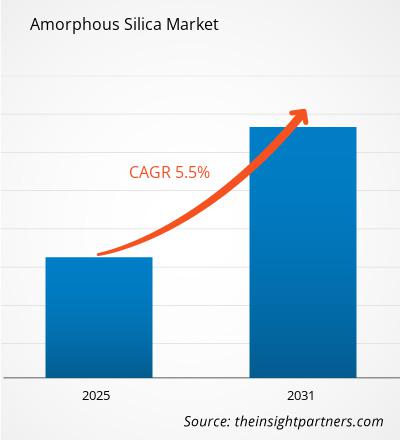无定形二氧化硅市场规模预计将从2024年的121.7亿美元增至2031年的174.7亿美元。预计2025年至2031年期间,该市场的复合年增长率将达到 5.5 %。绿色二氧化硅的日益普及可能会在预测期内带来新的市场趋势。
非晶态二氧化硅市场分析
全球建筑行业的快速扩张,加上各国政府投资的不断增加,推动了发展中国家对无定形二氧化硅的需求,无定形二氧化硅是现代建筑材料的关键成分。此外,这些经济体也为个人护理产品和食品加工企业提供了不断增长的市场,而沉淀无定形二氧化硅在这些市场中可用作增稠剂、抗结块剂和载体。可支配收入的增加、生活方式的改变以及人们卫生和美容意识的增强,促使这些地区个人护理产品和加工食品的消费量增加。因此,发展中国家无定形二氧化硅应用的蓬勃发展,为无定形二氧化硅市场带来了巨大的增长机遇。
无定形二氧化硅市场概况
受各种工业应用需求不断增长的推动,无定形二氧化硅市场正在稳步增长。无定形二氧化硅是一种非晶体形式的二氧化硅,因其高表面积、孔隙率和化学稳定性而受到重视,适用于一系列行业。它主要用作橡胶和塑料中的增强填料、食品中的抗结块剂、化妆品和个人护理用品中的增稠剂以及油漆和涂料中的消光剂。建筑和橡胶等行业日益增长的需求推动了无定形二氧化硅市场的发展,这些行业优先考虑轻质耐用的材料。这种二氧化硅是一种有效的添加剂,可在不影响可持续性的情况下提高产品性能。在电子和半导体领域,无定形二氧化硅在制造用于芯片制造的先进绝缘材料和抛光浆料方面发挥着至关重要的作用。化妆品和个人护理行业也在护肤配方中利用其吸油和光扩散特性。此外,市场正在见证生产方法的创新,转向更环保的工艺,例如基于稻壳灰的二氧化硅,从而减少对环境的影响。
您可以免费定制任何报告,包括本报告的部分内容、国家级分析、Excel 数据包,以及为初创企业和大学提供优惠和折扣
无定形二氧化硅市场:战略洞察

- 获取此报告的顶级关键市场趋势。此免费样品将包括数据分析,从市场趋势到估计和预测。
无定形二氧化硅市场驱动因素和机遇
蓬勃发展的建筑业
基础设施建设需求以及住宅和商业建筑项目的激增,支撑着全球建筑业的增长。随着发展中国家和发达经济体基础设施的持续发展,对机械强度更高、防潮性能更强、使用寿命更长的先进建筑材料的需求激增。无定形二氧化硅,尤其是硅粉,可用作混凝土和水泥基应用中的辅助胶凝材料。它有助于降低混凝土的孔隙率,增加其密度,并增强其抗化学侵蚀性能,使其特别适用于桥梁、水坝、隧道和海洋结构中使用的高性能混凝土的添加剂应用。此外,随着城市人口和住房需求的增长,尤其是在新兴经济体,住宅建筑的建设也蓬勃发展。各国政府机构也纷纷采取措施支持住宅建设项目。这种增长需要能够提高结构强度、耐久性和使用寿命的材料。无定形二氧化硅,尤其是硅粉,已被证明在加固建筑结构方面非常有效。因此,蓬勃发展的建筑业促进了无定形二氧化硅市场的发展。
新兴经济体的使用日益增多
中国、印度、巴西和东南亚国家快速的工业化和城镇化以及制造业的扩张,导致各种应用对无定形二氧化硅的需求增加,包括橡胶、油漆、涂料、建筑和电子行业。新兴经济体汽车产量的增加也推动了汽车和轮胎行业对高性能橡胶化合物的需求,无定形二氧化硅在这些行业中被广泛用作补强剂。根据国际能源署的年度全球电动汽车展望,到 2024 年,全球电动汽车销量将超过 1700 万辆,增长 25% 以上。随着汽车行业见证向电动汽车的转型,无定形二氧化硅在汽车领域的作用变得更加关键。无定形二氧化硅可提高轮胎的耐用性、抓地力和燃油效率,符合全球对节能环保汽车的推动。
无定形二氧化硅市场报告细分分析
有助于得出无定形二氧化硅市场分析的关键部分是等级、产品类型和应用。
- 按纯度等级划分,市场分为高纯度、中纯度和低纯度。2024年,中纯度市场占据最大份额。
- 就产品类型而言,无定形二氧化硅市场分为沉淀二氧化硅、硅胶、胶体二氧化硅、气相二氧化硅等。沉淀二氧化硅在2024年占据了最大的市场份额。
- 根据应用,市场可分为橡胶、电气和电子、建筑和施工、个人护理和化妆品、食品和饮料、石油和天然气、纸浆和造纸、农用化学品等。建筑和施工领域在2024年占据了最大的市场份额。
按地区划分的无定形二氧化硅市场份额分析
无定形二氧化硅市场报告的地理范围包括北美、亚太地区、欧洲、中东和非洲以及南美和中美。预计北美市场在预测期内将大幅增长。建筑业是北美无定形二氧化硅市场增长的重要推动力。随着住宅和商业项目的增加以及基础设施的大力发展,该行业一直在增长。根据美国人口普查局的一份报告,总建筑投资(包括私人和公共项目)增长 1.5%,从 2022 年的 19078 亿美元达到 2023 年的 20990 亿美元。根据美国建筑总承包商协会 (AGC) 的数据,美国建筑业每年的营业额接近 2.1 万亿美元。建筑行业对气相二氧化硅、胶体二氧化硅和沉淀二氧化硅的使用增加推动了该地区对无定形二氧化硅的需求。
此外,由于北美大部分人口非常注重身体健康,个人护理和化妆品行业蓬勃发展。根据国际贸易管理局的数据,墨西哥是全球十大化妆品和个人护理产品市场之一,也是北美第二大美容产品市场。过去几十年来,加拿大化妆品行业也蓬勃发展,其中多伦多处于化妆品发展的前沿。胶体二氧化硅、硅胶和气相二氧化硅因其在改善皮肤特性、产品稳定性、质地和紫外线防护方面的作用而被用作化妆品和个人护理产品的天然成分。因此,化妆品行业的强劲存在为北美无定形二氧化硅市场的增长提供了巨大的机会。
非晶态二氧化硅市场区域洞察
Insight Partners 的分析师已详尽阐述了预测期内影响无定形二氧化硅市场的区域趋势和因素。本节还讨论了北美、欧洲、亚太地区、中东和非洲以及南美和中美的无定形二氧化硅市场细分和地理分布。

- 获取无定形二氧化硅市场的区域具体数据
无定形二氧化硅市场报告范围
| 报告属性 | 细节 |
|---|---|
| 2024年的市场规模 | 121.7亿美元 |
| 2031年的市场规模 | 174.7亿美元 |
| 全球复合年增长率(2025-2031) | 5.5% |
| 史料 | 2021-2023 |
| 预测期 | 2025-2031 |
| 涵盖的领域 | 按年级
|
| 覆盖地区和国家 | 北美
|
| 市场领导者和主要公司简介 |
|
无定形二氧化硅市场参与者密度:了解其对业务动态的影响
无定形二氧化硅市场正在快速增长,这得益于终端用户需求的不断增长,而这些需求的驱动因素包括消费者偏好的不断变化、技术进步以及对产品优势的认知度不断提高。随着需求的增长,企业正在扩展产品线,不断创新以满足消费者需求,并抓住新兴趋势,从而进一步推动市场增长。
市场参与者密度是指特定市场或行业内企业或公司的分布情况。它表明特定市场空间内竞争对手(市场参与者)的数量相对于其规模或总市值而言。
在无定形二氧化硅市场运营的主要公司有:
- MLA工业集团
- 卡博特公司
- 洛拉德化学公司
- 康宁公司
- 中信集团有限公司
- 赢创工业股份公司
免责声明:以上列出的公司没有按照任何特定顺序排列。

- 获取无定形二氧化硅市场主要参与者的概述
无定形二氧化硅市场新闻和最新发展
通过收集一手资料和二手资料,以及重要的企业出版物、协会数据和数据库等定性和定量数据,我们对无定形二氧化硅市场进行了评估。以下列出了无定形二氧化硅市场的一些关键发展:
- 全球领先的二氧化硅生产商之一赢创投资扩建其位于美国查尔斯顿的沉淀二氧化硅生产工厂。这条位于南卡罗来纳州的新生产线旨在满足市场对这种材料的高需求,尤其是北美轮胎行业的需求。此次扩建旨在通过实现本地二氧化硅采购,增强赢创在该地区合作伙伴的供应链韧性。(来源:赢创,新闻稿,2024年1月)
- 索尔维公司在其位于意大利利沃诺的工厂投资,启动了该公司首套循环高分散二氧化硅 (HDS) 生产装置,该装置采用源自稻壳灰的生物基硅酸钠制成。该工厂的可再生能源整合将使索尔维每生产一吨二氧化硅可减少 50% 的二氧化碳排放量。这将使利沃诺工厂成为索尔维在欧洲二氧化碳排放量方面首屈一指的二氧化硅生产基地。该公司原计划于 2024 年底投产。(来源:索尔维公司,新闻稿,2023 年 1 月)
无定形二氧化硅市场报告范围和交付成果
《无定形二氧化硅市场规模和预测(2021-2031)》报告对以下领域进行了详细的市场分析:
- 范围内涵盖的所有主要细分市场的全球、区域和国家层面的无定形二氧化硅市场规模和预测
- 无定形二氧化硅市场趋势以及市场动态,例如驱动因素、限制因素和关键机遇
- 详细的波特五力模型和 SWOT 分析
- 无定形二氧化硅市场分析涵盖主要市场趋势、全球和区域框架、主要参与者、法规和最新市场发展
- 行业格局和竞争分析,涵盖市场集中度、热图分析、知名参与者以及非晶硅市场的最新发展
- 详细的公司简介
- 历史分析(2 年)、基准年、预测(7 年)及复合年增长率
- PEST和SWOT分析
- 市场规模、价值/数量 - 全球、区域、国家
- 行业和竞争格局
- Excel 数据集
近期报告
客户评价
购买理由
- 明智的决策
- 了解市场动态
- 竞争分析
- 客户洞察
- 市场预测
- 风险规避
- 战略规划
- 投资论证
- 识别新兴市场
- 优化营销策略
- 提升运营效率
- 顺应监管趋势




















 获取免费样品 - 非晶态二氧化硅市场
获取免费样品 - 非晶态二氧化硅市场